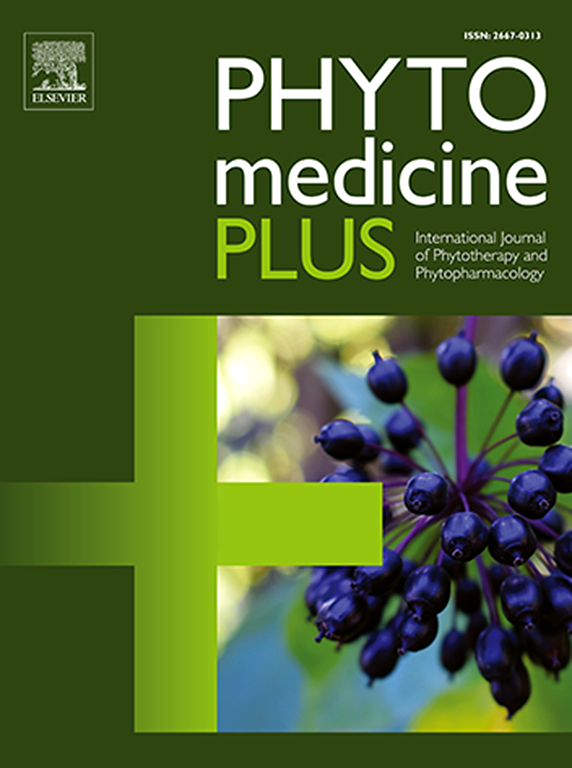筛选东南亚药用植物:黄缕草、Leea indica、strobilanthescrispa、牡荆trifolia的抗血小板聚集和凝血作用
Q3 Pharmacology, Toxicology and Pharmaceutics
引用次数: 0
摘要
东南亚传统医学长期以来一直使用草药来促进血液流动和溶解血栓。根据传统用途和文献资料,已经确定了四种植物-克罗西纳、印度利亚、石南花和荆芥-具有潜在的血液循环作用。虽然这些植物表现出各种药理活性,但它们对血小板聚集和凝血的具体影响仍未被探索。目的研究黄皮草(Clausena lanum)、Leea indica、Strobilanthes crispa和Vitex trifolia等植物提取物的抗血小板和抗凝血活性,为发现治疗血栓性疾病的新方法搭建传统医学与现代研究的桥梁。方法以鲜叶为原料制备水、70%乙醇和70%甲醇提取物。采用胶原诱导聚集法分析人全血血小板聚集。通过测定对凝血酶原时间(PT)和活化的部分凝血活素时间(aPTT)的影响来评估抗凝活性。结果所有Leea提取物和70%乙醇牡荆提取物均能显著抑制血小板聚集。黄皮草提取物促进血小板聚集。所有提取物均能延长PT和aPTT,其中以Leea indica和strobilanse crispa效果最好。液相色谱和飞行时间质谱(LC-ToF-MS)分析发现了没食子酸、没食子酸甲酯、没食子儿茶素、没食子儿茶素-3- o -没食子酸酯等多酚类化合物。这些化合物,特别是山奈酚、槲皮素、表没食子儿茶素-3- o -没食子酸酯和β-谷甾醇,通过多种机制,包括抑制血小板活化和各种凝血因子,促进了荔枝的有效抗血小板和抗凝血作用。结论本研究结果支持了传统中药利亚、鹤耳花和荆芥改善血液循环和抑制凝血的作用。Leea indica显示出显著的抗血小板和抗凝血活性,突出其在预防病理性血栓形成和相关心血管疾病方面的潜力。本文章由计算机程序翻译,如有差异,请以英文原文为准。

Screening Southeast Asian medicinal plants: Clausena lansium, Leea indica, Strobilanthes crispa, Vitex trifolia for anti-platelet aggregation and blood coagulation effects
Background
Southeast Asian traditional medicine has long utilized herbs for promoting blood flow and dissolving clots. Four plants - Clausena lansium, Leea indica, Strobilanthes crispa, and Vitex trifolia - have been identified for their potential effects on blood circulation based on traditional use and literature. While these plants exhibit various pharmacological activities, their specific impacts on platelet aggregation and coagulation remain unexplored.
Purpose
This study aims to investigate the antiplatelet and anticoagulant activities of extracts from Clausena lansium, Leea indica, Strobilanthes crispa, and Vitex trifolia, bridging traditional medicine with modern research to potentially uncover novel approaches for managing thrombotic disorders.
Methods
Aqueous, 70 % ethanolic, and 70 % methanolic extracts were prepared from fresh leaves. Platelet aggregation was analyzed using collagen-induced aggregation in human whole blood. Anticoagulant activities were evaluated by determining the effects on prothrombin time (PT) and activated partial thromboplastin time (aPTT).
Results
All Leea indica extracts and the 70 % ethanolic Vitex trifolia extract significantly inhibited platelet aggregation. Clausena lansium extracts promoted platelet aggregation. All extracts prolonged PT and aPTT, with Leea indica and Strobilanthes crispa being most potent. Liquid chromatography and time of flight mass spectrometry (LC-ToF-MS) analysis of Leea indica revealed gallic acid, methyl gallate, epigallocatechin, epigallocatechin-3-O-gallate, and other polyphenolic compounds. These compounds, particularly kaempferol, quercetin, epigallocatechin-3-O-gallate, and β-sitosterol, contribute to Leea indica's potent antiplatelet and anticoagulant effects through multiple mechanisms, including inhibition of platelet activation and various coagulation factors.
Conclusions
These findings support the traditional use of Leea indica, Strobilanthes crispa, and Vitex trifolia for improving blood circulation and inhibiting clotting. Leea indica demonstrated remarkable antiplatelet and anticoagulant activities, highlighting its potential in preventing pathological thrombus formation and related cardiovascular disorders.
求助全文
通过发布文献求助,成功后即可免费获取论文全文。
去求助
来源期刊

Phytomedicine Plus
Medicine-Complementary and Alternative Medicine
CiteScore
3.70
自引率
0.00%
发文量
178
审稿时长
81 days
期刊介绍:
 求助内容:
求助内容: 应助结果提醒方式:
应助结果提醒方式:


